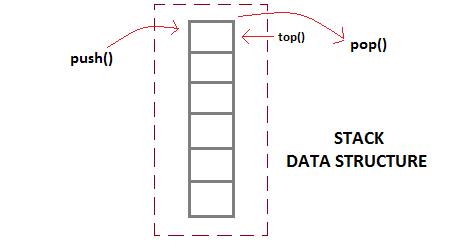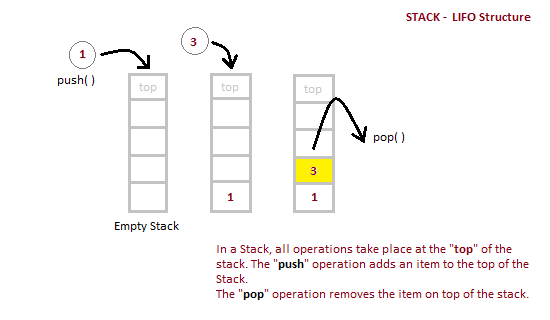What is Stack Data Structure?
What is Stack Data Structure?
Stack is an abstract data type with a bounded(predefined) capacity. It is a simple data structure that allows adding and removing elements in a particular order. Every time an element is added, it goes on the top of the stack and the only element that can be removed is the element that is at the top of the stack, just like a pile of objects.

Basic features of Stack
- Stack is an ordered list of similar data type.
- Stack is a LIFO(Last in First out) structure or we can say FILO(First in Last out).
push()function is used to insert new elements into the Stack andpop()function is used to remove an element from the stack. Both insertion and removal are allowed at only one end of Stack called Top.- Stack is said to be in Overflow state when it is completely full and is said to be in Underflow state if it is completely empty.
Applications of Stack
The simplest application of a stack is to reverse a word. You push a given word to stack - letter by letter - and then pop letters from the stack.
There are other uses also like:
- Parsing
- Expression Conversion(Infix to Postfix, Postfix to Prefix etc)
Implementation of Stack Data Structure
Stack can be easily implemented using an Array or a Linked List. Arrays are quick, but are limited in size and Linked List requires overhead to allocate, link, unlink, and deallocate, but is not limited in size. Here we will implement Stack using array.

Algorithm for PUSH operation
- Check if the stack is full or not.
- If the stack is full, then print error of overflow and exit the program.
- If the stack is not full, then increment the top and add the element.
Algorithm for POP operation
- Check if the stack is empty or not.
- If the stack is empty, then print error of underflow and exit the program.
- If the stack is not empty, then print the element at the top and decrement the top.
Below we have a simple C++ program implementing stack data structure while following the object oriented programming concepts.
/* Below program is written in C++ language */
# include<iostream>
using namespace std;
class Stack
{
int top;
public:
int a[10]; //Maximum size of Stack
Stack()
{
top = -1;
}
// declaring all the function
void push(int x);
int pop();
void isEmpty();
};
// function to insert data into stack
void Stack::push(int x)
{
if(top >= 10)
{
cout << "Stack Overflow \n";
}
else
{
a[++top] = x;
cout << "Element Inserted \n";
}
}
// function to remove data from the top of the stack
int Stack::pop()
{
if(top < 0)
{
cout << "Stack Underflow \n";
return 0;
}
else
{
int d = a[top--];
return d;
}
}
// function to check if stack is empty
void Stack::isEmpty()
{
if(top < 0)
{
cout << "Stack is empty \n";
}
else
{
cout << "Stack is not empty \n";
}
}
// main function
int main() {
Stack s1;
s1.push(10);
s1.push(100);
/*
preform whatever operation you want on the stack
*/
}
Position of Top
|
Status of Stack
|
|---|---|
-1 | Stack is Empty |
0 | Only one element in Stack |
N-1 | Stack is Full |
N | Overflow state of Stack |
Analysis of Stack Operations
Below mentioned are the time complexities for various operations that can be performed on the Stack data structure.
- Push Operation : O(1)
- Pop Operation : O(1)
- Top Operation : O(1)
- Search Operation : O(n)
The time complexities for
push() and pop() functions are O(1) because we always have to insert or remove the data from the top of the stack, which is a one step process.
Comments
Post a Comment
Thanks for comment. We will get back to you soon...